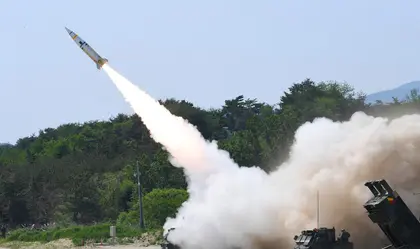Aerial attacks using conventional cruise missiles, as well as Russia’s Kinzhal and Tsirkon “unstoppable wonder weapons,” have not proved as effective as the Kremlin hoped, largely because of their vulnerability to Western air defense weapons, such as the US Patriot system, their cost and the relatively limited numbers available.
It is the conversion of the thousands of dumb aircraft bombs lying in Moscow’s storehouses into smart, satellite guided long-range that have become Russia’s most effective weapon in attacks on the lines of engagement and the vulnerable border settlements.
JOIN US ON TELEGRAM
Follow our coverage of the war on the @Kyivpost_official.
The appearance of aerial bombs fitted with so-called Unified Planning and Correction Modules (UMPK) cost effectively transforms them into what the military jargon calls trajectory-corrected aerial bombs (KABs).
The concept is not new. As with so many modern weapons, it was the Germans in World War II that first came up with the idea.
In September 1943 the Italian fleet was sailing to Malta to surrender when a Dornier Do-217 bomber dropped two aerial bombs, fitted with flip-out wings, which glided from what was perceived as being a “safe distance” away, struck and destroyed the Italian battleship, Roma.
The US developed the concept through several stages, including laser-guided bombs (LGBs) and other airborne weapons beginning in the 1960s, until in the late 1990s they produced the Joint Direct Attack Munition (JDAM) add-on kit that converted its aircraft bombs into guided aerial weapons. At a cost of around $20,000 the addition of a combined inertial and GPs guidance package and a steerable tail produced easily manufactured, precision-guided munitions at much lower cost purpose-built guided weapons such as the more expensive aerial LGBs, and ground forces’ HIMARS or ATACMS missiles.

Why Is Russia so Mad? Five Things to Know About Ukraine’s Recent Missile Strikes Against Russia
It is only surprising that it took almost two years of war for the Kremlin to realize and capitalize on the tactical and potentially strategic value of such a weapon. Glide bombs have belatedly allowed Russia’s air force to provide the meaningful support its ground forces have lacked for most of the time.
Previously its aircraft have had to stay too far back from the front lines for fear of Ukraine air defenses to provide the level of air support the sheer numbers of Russian aircraft could and should have been providing. The use of UMPK kits to produce KABs allows aircraft to still to remain relatively safe from surface to air missiles while launching the weapons as far 60 or 70 kilometers behind the front line, to attack and destroy Ukrainian ground defenses ahead of advances by Russian troops.
A recent article published by the Ukrainian Defense Express military issues website analyzed the use of the weapons on recent Russian UMPK/KAB missions against Kharkiv and Ukrainian military based on open source images released on social media. It showed four of the weapons being released over the Belgorod region 50 kilometers from the Ukrainian border and 40 kilometers from the town of Vovchansk which was the scene of heavy fighting when the images were captured.
The article commented that the wings of one of the munitions had not deployed which could have been one of the more than 50 unexploded aerial bombs discovered over the region this year following so-called “abnormal munitions releases.”

Not content with the advantage these weapons might give them on the battlefield, Moscow has seized, with alacrity, the potential of KABs as terror weapons striking residential and commercial areas of settlements close to the front line causing immense destruction and large numbers of civilian casualties.
The attack on the Epicentr store on Saturday, May 25 which killed as many as 20 and wounded almost a hundred civilians exemplifies Putin’s continuing strategy of terror.
It need not have happened.
Russian and Ukrainian milbloggers have identified the Baltimor airfield near the Russian city of Voronezh as the base for the aircraft, which were probably Sukhoi Su-34 fighter-bombers (NATO: Fullback), that launched Saturday’s attack. This is closer than the airfields in Crimea, such as Belbek, which Ukraine attacked with missiles earlier in the month. At around 250 kilometers from the nearest Ukrainian-held territory, Baltimor is well within range of the ATACMS missiles recently supplied to Kyiv which they are currently prevented from using cross-border.
Similarly, the location inside Russia from where the KABs were launched would be well within the range of Western supplied air defense missiles such as Patriot and NASAMS.
While the ability to use Western weapons to hit targets in Russia would not wholly prevent attacks occurring it could force Russia to move its assets further away from Ukraine making them less easy to deploy and less effective as they would have to be used further back. Currently Russia knows it can operate with impunity and is making the most of the window of opportunity while, as usual, Washington and others dither.
You can also highlight the text and press Ctrl + Enter






